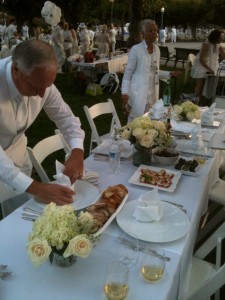 In the wrong hands, this event could have been a recipe for a disaster.
In the wrong hands, this event could have been a recipe for a disaster.
Instead, it was the breathtaking beautiful and enchanting Le Diner a San Francisco, the city’s adaptation of the famous Parisian Le Diner en Blanc.
Picture 3,000 people agreeing to gather at a secret location on Friday, October 14. Until 4 pm that day, we only knew that we were to arrive somewhere within San Francisco and set up during a 90-minute window, from 5:30 to 7 pm.
We did have explicit directions on what to wear and what to bring in addition to when to show up. We also knew what we would do—dine under the stars at a gourmet picnic.
Then, a few minutes before 4 pm—as promised—one member of our four-person party received an email from the event organizers with the missing information. She relayed the message: Convene at the historical Music Concourse in Golden Gate Park.
The event organizers trusted that their points of contact would promptly inform their guests of the last missing piece of information. And the organizers also trusted us to show up on time dressed for the occasion.
And sure enough, a few thousand of us appeared, blizzard-like, wearing all white formal clothes.
We unfurled our white tablecloths, folded our white napkins, decorated our tables, unpacked our food, popped our champagne corks and settled in for a feast under the moon. Between courses many of us strolled between the fountains, visiting with friends and strangers, marveling on the magical evening. (The local CBS News station captured the essence of the evening well in this coverage.)
In this day and age, it was amazing to see so many strangers following orders and enjoying themselves while doing so. Are there lessons learned that we can apply in our organizations to get people so engaged and involved?
Yes, although exclusivity helps. This event was invitation-only and limited in a city that relishes fine dining. My foodie friends weren’t even too sure how they got on the invitation list, but they didn’t question it. (Granted, many organizations limit participation as well, but with a different feel. The “outs” often want to be in, and the “ins” sometimes would prefer to be elsewhere, which is a whole different story….)
However, the Le Diner organizers also adopted three crucial practices. These practices are also commonly discussed, but not always fully put into place.
First. the organizers did meticulous planning, started well in advance. We first learned about the picnic in late July—more than 10 weeks in advance. So we had ample time to clear out schedule, figure out what to wear, and what to eat and drink that would travel well at room temperature.
Second. The organizers used and supported the “SPOC”—single point of contact—which they called the “Head of the Table.” They tapped this individual to be the link between the event organizers and the guests. The “Head of the Table” was responsible for inviting three other guests and arranging everything, such as figuring out who would bring chairs, table settings, food, drinks and white trash bags to pack everything out.
Third. The organizers provided extremely clear instructions, all through email. The messages were simple for the SPOCs to forward. The organizers also supplemented the email communication with a website, a Facebook page and Twitter posts. All the messages were to the point, with explicit directives. As I tweeted a week before le diner, “Impressed that @LeDinerSF has already shared agenda for 10/14 white picnic. Not true for my other meetings this week, http://bit.ly/oz7TbL.”
While the organizers issued strict edicts about certain aspects of the events, they also gave the SPOCs/Heads of Table and their guests leeway on many meaningful issues, namely our menu, décor and dress.
For example, we could join other groups. (Ours numbered eight; six of us are pictured here.) And once we got to the picnic site, we chose our table location. We also decided when to start eating once we set everything up. (The agenda did call for us to wave our white napkins at 7:30 pm, which we all did with gusto.)
This combination of community and creativity within a well-defined structure contributed to an unforgettable experience. Having event organizers we trusted and who trusted us helped too. And of course, wonderful food and wine in a gorgeous setting certainly add to the ambiance.
Le Diner was as a “time magnet” that cut through the clutter and absorbed us. As Adrian Ott, the author of The 24-Hour Customer: New Rules for Winning in a Time-Starved, Always-Connected Economy, says, we like to spend our time pursuing personal pursuits, improving our status, and increasing our acceptance with family, friends, and co-workers. (For more about this, see Be time wise when providing wisdom.)
Yet, if we could regularly apply these three lessons to our other events, we could make them more meaningful and memorable.
What do you think?

0 Comments